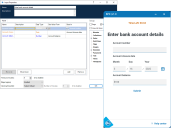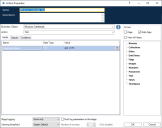Process development for Desktop
Automations for use in SS&C | Blue Prism® Desktop can be developed using current SS&C | Blue Prism® Enterprise functionality and methodology. This guide describes the differences between a standard Blue Prism interactive client and a Blue Prism interactive client with a Desktop license applied, and outlines special considerations when developing processes for Desktop.
Before creating a Blue Prism process to run in Desktop, it is recommended that you refer to Desktop process design considerations for a suggested design approach.
Process design elements for Desktop
Blue Prism process developers can create automations to run on Desktop. The processes can incorporate forms (using an Input stage), which prompt the Desktop user to enter data required to complete the process. All published processes stored in the Blue Prism database can be made available using role permissions to connected Desktop users, and access can be controlled using existing permissions functionality.
The following design elements should be considered when creating a process to run in Desktop:
Start stage
The Start stage can be used in Blue Prism processes to add start-up parameters to a process. When input parameters are added to a Start stage, they are displayed as a form in Desktop to enable the Desktopclient user to enter required parameters before running the process. See
The following image shows the Start stage in Blue Prism and the corresponding form in Desktop.
Input stage
The Input stage can be used in Blue Prism processes to add a form to a process. This stage is only available for users with a Desktop license. See
The following image shows the Input stage in Blue Prism and the corresponding form in Desktop.
If your process includes an Input stage, a debug form displays the input fields when run in Process Studio in Desktop debug mode. This enables you to create and test a process without having to publish and run it in Desktop.
The style of the debug form displayed in Process Studio does not match the style used in the Desktop user interface, but provides an accurate representation of the content.
Session timeout
A mandatory 10 minute session limit is automatically applied to all processes running in Desktop, after which time, the process is stopped. If a timeout occurs, it is captured in the session history in the Blue Prism interactive client and displayed on the View issues screen in Desktop.
The 10 minute timer is paused while an input form is open. See
This is the default setting of the session run time limit, which means that Desktop processes must be designed with this restriction in mind, as standard. However, if you have a use case that requires a higher time limit, please contact the Desktop team at [email protected] for details on how it can be increased.
Windows Credentials business object
As Desktop is a tool used by Desktop users on their machines, using their profile, accounts, and credentials, Desktop processes do not have access to the Blue Prism credential store, and users’ credentials are not stored in the Blue Prism database.
The Windows Credentials business object can be used to access users’ credentials stored locally for use with Desktop processes. The Windows Credentials business object interacts with credentials stored under Control Panel > User Accounts > Credential Manager > Windows Credentials > Generic Credentials.
The following actions are available:
- Get – Retrieves the specified credentials.
- Set – Populates given credential name with specified values for username and password.
|
Parameter |
Direction |
Data type |
Description |
|---|---|---|---|
| Credentials Name | In | Text | The internet or network address from the Windows Credential Manager. |
| Username | Out | Text | The user name for the specified credential. |
| Password | Out | Password | The password for the specified credential. |
|
Parameter |
Direction |
Data type |
Description |
|---|---|---|---|
| Credentials Name | In | Text | The name of the credentials to set. This will be saved in the internet or network address field in the Windows Credentials Manager. |
| Username | In | Text | The user name for the specified credential. |
| Password | In | Password | The password for the specified credential. |
User credentials in Blue Prism Desktop
In Blue Prism Desktop, users can view, edit, and delete their own credentials from Settings > Credentials.
For details see Configure credentials.
User input blocking
User input blocking in Desktop helps prevent accidental updates by the user while applications are being automated. Generally, users will not be prevented from interacting with other applications while a process is running, however, there are some exceptions which are detailed below.
When Desktop automates an application, user input (for example, mouse clicks and key strokes) is blocked whilst the automation is running:
- If automating a Windows application, only the application being automated is blocked. All other Windows applications on the machine remain operational and will accept user inputs.
- If automating a Java, Microsoft Word, Excel, PowerPoint, Outlook, or browser application, all applications of that type on the machine are blocked. However, only one type of browser window is blocked so, for example, if Chrome is being automated, Edge, or Firefox will continue to work as expected.
If you already have Microsoft Word, Excel, PowerPoint, or Outlook open on your computer when a Desktop process automates the same application, interactions with that application may not be blocked. Any interactions that you make with the application could cause the process to run with incorrect data or to fail, so it is recommended that you save and close Word, Excel, PowerPoint, or Outlook before running a process that automates these applications.
Depending on process design, the sending of mouse clicks from Blue Prism may require the target application to be in focus. It is recommended, where possible, that approaches to send mouse clicks to applications that do not require focus are used. Details of these options are listed below:
- Mouse clicks can be sent to Windows applications using the Press or Press Menu Item actions to avoid moving a user’s mouse. When performing a Press or Press Menu Item action, the Windows application under automation may come into focus. Users can move focus to other applications once the action has completed.
- Mouse clicks can be sent to a Java application in a way that does not move the mouse or steal the focus, as these other actions are all API driven through the Java Access Bridge.
- Mouse clicks can be sent to browser applications using the Click action available in Browser spy mode.
Sending key strokes:
- Key strokes can be sent to a Windows application without stealing focus, by using the Windows Press Keys action.
- Key strokes can be sent to a target Java application, but not a specific element.
- Text can be written to a browser application using Write stages. There is no option to send individual key strokes to a browser window other than using Global Send Keys, which requires the application window to be in focus.
Touchpad actions that are not blocked
When running a process in Desktop, the following touchpad actions related to gestures are not blocked in applications automated by the process:
-
Pinch to zoom in and stretch to zoom out.
- Drag two fingers to scroll.
- Tap two fingers to mimic right-click.
Differences in Blue Prism functionality
The following sections describe the differences that apply to the Blue Prism interactive client with a Desktop license applied:
Environment functions
The IsStopRequested environment function is not available in Calculation and Decision stages for business objects and processes. This is because it cannot be used to return a meaningful response in Desktop. Any existing processes that use this function will return False.
The
When running a business object or process that includes the IsBPDEnvironment environment function in debug mode in Studio, the function will return No, which indicates that a Blue Prism Enterprise resource is running.
Internal business objects
The following internal business objects are available for use when using the Blue Prism interactive client with a Desktop license:
- Internal Business Objects – Collections.
- Internal Business Objects – Windows Credentials. See Windows Credentials business object for details.
No other internal business objects are available with a Desktop license.
Spying
All spy modes available in this release of Blue Prism are fully compatible with Desktop, with the exception of Region mode. Region mode is available, but is not recommended for use in Desktop processes, due to potentially varying screen resolutions and other differing factors.
Excluded functionality
The following Blue Prism Enterprise functionality is not currently available in the Blue Prism interactive client if a Desktop license has been applied:
- Work queues – Desktop is not designed to operate like a Blue Prism Enterprise runtime resource, completing one case after another in batch mode, and potentially sharing data with other runtime resources via a common work queue. Desktop is intended to operate in isolation from other runtime resources, controlled by the Desktop user, working cases individually. For this reason, Desktop solutions do not have access to Blue Prism work queues and cannot use the Work Queues VBO. Work queues are not available in System or in Control Room.
-
Environment locks – The Desktop solution does not work simultaneously with other Blue Prism processes, so it has no need for environment locks. The Environment Locking VBO and the Environment Locks screen are not available.
- Schedules – Desktop is not designed to work with the Scheduler, therefore schedules are not available in System or Control Room.
- Calendars – Desktop is not designed to work with calendars, therefore the Calendars VBO will not function in a Desktop solution. Calendars are not available in System or Control Room.
- Data Gateways – Desktop is not designed to work with Data Gateways, therefore the Data Gateways VBO will not function in Desktop solutions.
- Enterprise credentials – Desktop client users will use their own local Windows credentials in processes, rather than credentials stored in Blue Prism, so the ability to use credential functionality in Blue Prism is not required.
- Session control functionality – The ability to start and stop sessions in Control Room is not available.
-
Automatic archiving – The ability to select automatic mode on the System - Archiving screen is unavailable.
Because work queue functionality is not available for Desktop, the System > Reporting - Work Queue Snapshots option is also not available.
 Docs
Docs



